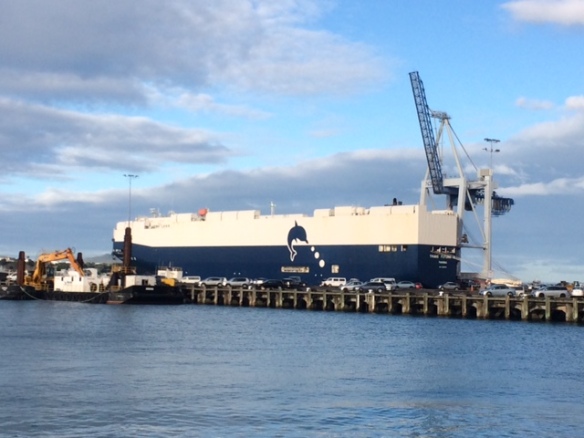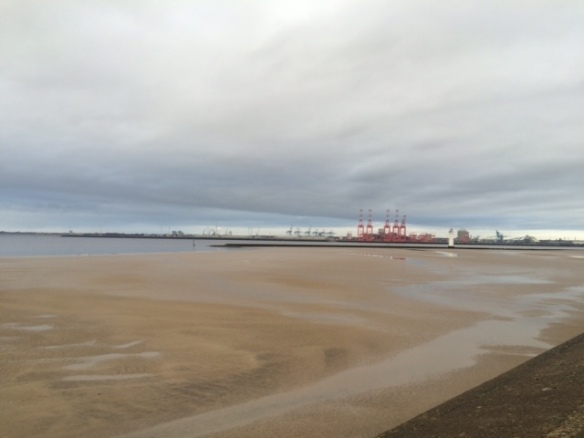
The Trans Future unloading in Auckland, NZ. Ships help to carry 96% of goods around our world (Photo: K Peters)
Post by Kimberley Peters
Breaking chains: the threat of piracy
Just a few years ago the threat of piracy – the seizure of huge cargo ships and the holding hostage of their crews – loomed large off of the coast of Somalia. This illicit maritime activity, which is many centuries old and can be traced back to the earliest seafaring (see Hasty 2014), was a cause for global concern. Ships are the technologies that link spaces together for the majority of trade (96% to be exact). Moreover, much of that trade travels through piracy ‘hotspots’ – voyaging through the Suez Canal linking Europe with the Middle East and South-East Asia.
As was depicted in the Hollywood film Captain Phillips (based on the events experienced by the real Captain Phillips) piracy has costs. There are, for shipping companies, large economic costs of training crews, installing water cannons and locking systems onto vessels, and, of course, rising insurance premiums. At the height of the piracy crisis (which coincided with a fall in oil prices) it was cheaper for vessels to travel around the African continent, following 18th and 19th century colonial trade routes, than to journey via Suez and the Somali coast. Higher costs for shipping translate, ultimately, into higher costs for us as consumers. But there are also other costs – the costs to lives, of those victim to piracy, but also those in war-torn countries who commit such offshore acts.
The spate of piratical acts over the last decade has alerted the world to the often invisible world that exists offshore (Urry 2014). It has also alerted us to the fact that the chains that keep things moving A to B, are not unbreakable. When we go shopping – for food, clothes, a new mobile phone – almost all of these things will have travelled on a ship across the oceans, connecting us to the world beyond dry land and to the lives of those offshore who are making (and breaking) those commodity chains (see Peters 2010).
Today, we hear less of piracy in the news. This is partly due to better oceanic governance to prevent it, and efforts onshore to assist the rebuilding of communities who often have little option but to turn to crime at sea (see the excellent work of Gilmer on piracy in the recent issue of Geoforum, 2016). But just because piracy is not as visible as it has been, doesn’t mean that it is all plain sailing for those who facilitate the supply chains that keep our shop shelves stacked.
Stuck in limbo: when shipping companies go bust
In the past few months we’ve seen a new crisis emerge as global shipping firm Hanjin went bust. As geographers Stephen Graham and Nigel Thrift have argued (2007), we often fail to recognise the infrastructural systems that keep our world functioning: the pipes, cables, roads, cars, planes and even ships – that are part of networks which keep things moving A to B. It is only when things fail we notice these invisible systems (piracy for example, made the closed world of shipping suddenly very visible). The Hanjin crisis did the same.
When the company was declared insolvent, ships and their crews were stuck out at sea with nowhere to go (see this BBC report). Ports refused them entry knowing the bankrupt company would not be able to pay the port fees. Captains and workers were stranded on board. The thousands of container boxes carried by the ships were undelivered – trapped in an oceanic limbo. Supply chains were severed. Cars failed to arrive in showrooms. Electrical goods failed to reach their destination. Personal items shipped overseas were left bobbing about offshore. Again, this instance alerts us to the fundamental but fragile role of shipping in everyday life.

Viewed from the New Brighton beach, the Liverpool2 container port. This recent development will enable the city to welcome some of the world’s largest vessels (Photo: K Peters)
Keeping things moving: new developments
In recent months we have been confronted with the global world of shipping in new ways here in Liverpool. The opening of the new Liverpool2 docks in November 2016 will enable the world’s largest ships – of 400 meters and above – to enter the port. Liverpool, it is anticipated, will become a new hub of global trade in the North of England – a key site for enabling those vital connections that move things from A to B (see this BBC report).
The difference this will make for Liverpool, the north-west region, and to the world of commerce and trade is, as yet, unclear. It is argued it will bring more jobs and greater prosperity to the area. It may also create new global links between Liverpool and the rest of the world. As such, what happens at sea, on ships, and in ports matters to us here on land (as myself and colleagues have argued elsewhere, see Anderson and Peters 2014). Developments like Liverpool2 are part of the network of infrastructures that keep things moving and enable us to access the goods and resources essential to our daily lives (see also this recent article on the Geographical Magazine website).
So next time you go shopping, spare a thought for the oceanic connections interwoven with the things you buy, and the geographic processes, and infrastructural maintenance that has enabled them to reach our shores. And if this has sparked your interest, we explore some of these themes in the new ENVS339 Maritime Geographies module in the Department of Geography and Planning in Spring 2017, taught by myself, Prof. Andy Plater and Dr. Andy Davies.
